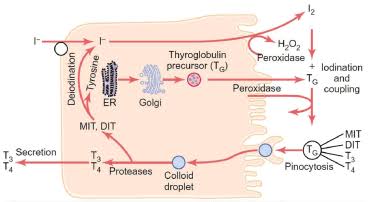
THYROID METABOLIC HORMONES
Mechanism of Action and Physiologic Effects of Thyroid Hormones
Thyroid Hormone Receptors and Mechanism of Action
Receptors for thyroid hormones are intracellular DNA-binding proteins that function as hormone-responsive transcription factors, very similar conceptually to the receptors for steroid hormones.
Thyroid hormones enter cells through membrane transporter proteins. A number of plasma membrane transporters have been identified, some of which require ATP hydrolysis; the relative importance of different carrier systems is not yet clear and may differ among tissues. Once inside the nucleus, the hormone binds its receptor, and the hormone-receptor complex interacts with specific sequences of DNA in the promoters of responsive genes. The effect of the hormone-receptor complex binding to DNA is to modulate gene expression, either by stimulating or inhibiting transcription of specific genes.
For the purpose of illustration, consider one mechanism by which thyroid hormones increase the strength of contraction of the heart. Cardiac contractility depends, in part, on the relative ratio of different types of myosin proteins in cardiac muscle. Transcription of some myosin genes is stimulated by thyroid hormones, while transcription of others in inhibited. The net effect is to alter the ratio toward increased contractility.
For additional details on mechanism of action and how these receptors interact with other transcription factors, examine the section Thyroid Hormone Receptors.
Physiologic Effects of Thyroid Hormones
It is likely that all cells in the body are targets for thyroid hormones. While not strictly necessary for life, thyroid hormones have profound effects on many "big time" physiologic processes, such as development, growth and metabolism, and deficiency in thyroid hormones is not compatible with normal health. Additionally, many of the effects of thyroid hormone have been delineated by study of deficiency and excess states, as discussed briefly below.
Metabolism: Thyroid hormones stimulate diverse metabolic activities most tissues, leading to an increase in basal metabolic rate. One consequence of this activity is to increase body heat production, which seems to result, at least in part, from increased oxygen consumption and rates of ATP hydrolysis. By way of analogy, the action of thyroid hormones is akin to blowing on a smouldering fire. A few examples of specific metabolic effects of thyroid hormones include:
- Lipid metabolism: Increased thyroid hormone levels stimulate fat mobilization, leading to increased concentrations of fatty acids in plasma. They also enhance oxidation of fatty acids in many tissues. Finally, plasma concentrations of cholesterol and triglycerides are inversely correlated with thyroid hormone levels - one diagnostic indiction of hypothyroidism is increased blood cholesterol concentration.
- Carbohydrate metabolism: Thyroid hormones stimulate almost all aspects of carbohydrate metabolism, including enhancement of insulin-dependent entry of glucose into cells and increased gluconeogenesis and glycogenolysis to generate free glucose.
Growth: Thyroid hormones are clearly necessary for normal growth in children and young animals, as evidenced by the growth-retardation observed in thyroid deficiency. Not surprisingly, the growth-promoting effect of thyroid hormones is intimately intertwined with that of growth hormone, a clear indiction that complex physiologic processes like growth depend upon multiple endocrine controls.
Development: A classical experiment in endocrinology was the demonstration that tadpoles deprived of thyroid hormone failed to undergo metamorphosis into frogs. Of critical importance in mammals is the fact that normal levels of thyroid hormone are essential to the development of the fetal and neonatal brain.
Other Effects: As mentioned above, there do not seem to be organs and tissues that are not affected by thyroid hormones. A few additional, well-documented effects of thyroid hormones include:
- Cardiovascular system: Thyroid hormones increases heart rate, cardiac contractility and cardiac output. They also promote vasodilation, which leads to enhanced blood flow to many organs.
- Central nervous system: Both decreased and increased concentrations of thyroid hormones lead to alterations in mental state. Too little thyroid hormone, and the individual tends to feel mentally sluggish, while too much induces anxiety and nervousness.
- Reproductive system: Normal reproductive behavior and physiology is dependent on having essentially normal levels of thyroid hormone. Hypothyroidism in particular is commonly associated with infertility.
At the end of this lesson, students will be able to know about
- Synthesis and secretion of thyroid hormones
- Iodide pump
- functions of Thyroid hormones
- Regulation of secretion


